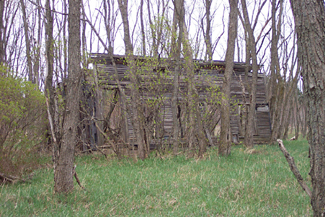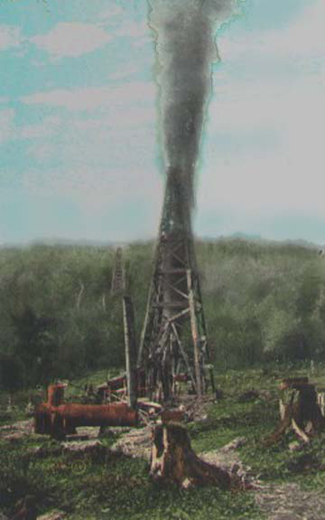Ghost Towns of Newaygo
 Boom or Bust, Live or Die
Boom or Bust, Live or Die
The opening of the Old Northwest Territory was an era of great changes for Michigan. The Native Americans were being moved onto reservations and the "barons" were exploiting every possible natural resource. Once the forests, mines, and open agricultural lands (prairies) were used up, the settlers and farmers came in to plant crops and raise livestock in the denuded forests and smaller prairie remnants.
Early on, due to the unavailability of powered technologies, these changes came at the price of hardships and hard labor. Work crews using four-legged "horsepower" created the farms, fields, roads, and towns that sprung up around the remaining resources. Once the railroad came in, "modern" equipment (for those days) and more workers poured into areas that were built on the sweat, blood, and tears of the earlier natives and settlers, making it easier and faster to use up the remaining resources.
Around the time the territory became a state, boomtowns sprung up around mines, lumber camps, and farming communities. These early towns were prosperous only as long as the mines produced, the forests had mature trees and the farmlands remained fertile and productive. Most boomtowns owed their existence to the resources they processed and sent to the big cities. Once the resources were used up, the "barons" moved on to the next mining "strike" or stand of old-growth forest. They would "pull up stakes" and head on to the next opportunity in some newly opened territory. Of course, they would take their equipment, workers, and money with them. This would cause the supporting businesses, like general stores, blacksmith shops, bars, banks, and brothels, to follow the money to the next "boom". A large percentage of the early towns were built on this "boom and bust" model and were so doomed from the beginning to become "ghost towns" of abandoned buildings and overgrown farm lots.
Many boomtowns quickly depopulate and leave behind buildings falling over in disrepair. Some towns were moved piece-by-piece and reassembled in the new boomtown locations rather than be left behind to rot. In humid environments like Michigan, most ghost towns rot away and become very hard to find. To research and list all the boomtowns and lumber or mining camps in Michigan would be a daunting task and a book-sized publication. With that in mind, I"ll present a cross-section of town histories from Newaygo County. View this comprehensive
map of Old Newaygo
that contains the names and dates of the early towns. The map is a PDF file, so you'll need Acrobat Reader to see it.
When settlement began in Newaygo County, towns first appeared on rivers, normally near a mill that used the river for waterpower. Other towns sprang up in willy-nilly fashion when and where some opportunity presented itself. Naturally, the first towns in the area were the "Indian" villages. Although the Native Americans had some permanent settlements as far north as Newaygo, most of their northern villages were seasonal camps. Once the settlers moved in and offered year-round trade with the natives, some camps became towns. Old Women's Bend, or Indian Town, on the Muskegon River, was one such town. A. L. Spooner in his article "MUSKEGON RIVER TRADING POSTS" describes Indian Town as follows.
"The Indians followed in numbers to this trading post and soon a village of 35 or 40 log cabins clustered around it on the flats on both sides of the river and Indian Town became an important village. Many bark teepees dotted the landscape and a log church was built in which regular monthly services were held. With the coming of the lumbermen, the river had to be flooded to carry the logs over the more shallow places. These floods also flooded the flats where the village was located and it was necessary to move the cabins to higher ground. In due course of time, they became dilapidated and most of them perished from exposure. The log trading post had been protected with siding and remained in habitable condition until 1917 when it was torn down."
Ryan's Corners in Croton and Brooks Township is an example of a boomtown that catered to the lumbering industry and disappeared after the industry collapsed. Here is a quote from "The Forming of Newaygo County Lumbering Days and Post Offices" by Terry Wantz describing Ryan's Corners.
"In the early (18) '50s, a small settlement developed in the northern part of Newaygo Township . . . called Ryan's Corners. It was located on the Grand Rapids Big Rapids Stage Coach Line. Jeremiah Ryan had a store on the southeast corner, Powers had a tavern on the northeast corner and Tripps had a store on the northwest corner. One mile south of this corner; two hotels were located, the Spencer House and the Washington House."
Apparently, Ryan's Corners was such a big party town that it became known as "Hell"s Corners". I've driven around that area and couldn't find any indication of the town ever being there. As with most Michigan ghost towns, the exact location would have to be pinpointed in order to find any evidence of its existence.
Some of the early towns moved forward to become long-lasting cities. These boomtowns that refused to bust outlasted the ghost towns mostly due to their geographical location and the establishment of sustainable industries. Cities like Newaygo and White Cloud rolled with the changes and survived to become the thriving communities they are today. "Alleytown", now a subdivision of White Cloud, used to be White Cloud's greatest competition in the lumber industry (White Cloud was then known as Morgan Station). When the tree stands played out and lumbering ended, White Cloud grew and absorbed Alleytown altogether.
The life cycle of the town created by the "boom and bust" model has the following progression; a booming industry starts a small community, its population increases until a post office is needed, the town incorporates around the peak of the local industry, finally, the bust causes the town to depopulate leaving behind only a fraction of the industries that gave it prosperity. These towns shrink, dissolve their incorporation, and slowly disappear entirely, leaving behind only a cemetery or a place name. Diehards persist or perish until new industries are introduced to take advantage of opportunities and leftover resources.
This boom-and-bust mentality, like "primitive" slash-and-burn agriculture, is an unsustainable and destructive practice that should be abandoned just like the ghost towns were. We need a new model that offers productivity and sustainability rather than depletion and abandonment. Unfortunately, big businesses still employ this boom and bust model and will move on to the newest and most profitable territories opened up for exploitation. Agreements like NAFTA and CAFTA are making it possible for U.S. businesses to move into new territories with fresh resources and cheap, abundant labor. The global marketplace is the final frontier for the new "barons" to "boom" in. These companies leave the U.S. (and its local employees) to become multinational corporations with powers akin to a sovereign foreign state. The United States didn't invent the boom and bust model, but our businesses have perpetuated it and the biggest and most bloated corporations live by it like it was gospel from Bible.
Comment about this article on the
Epress Forum Board
.
|
|
Michigan Oil Boom
 Michigan's Wildcat Days
Michigan's Wildcat Days
Michigan has something in common with Middle Eastern countries and it isn't endless deserts, camels, and date palm trees, it's oil! Certainly, the production of oil in this state can't compare with the Middle East or even Texas, but we had our oil strikes and gushing wells. Although Michigan is not generally known for being an oil-producing state, oil production peaked three times (in the 1930's, early 1960's and in the 1970-1980's). Michigan has continued to produce oil well into the 1990s and may produce yet more in the 21st century.
During the 1930's, oil and natural gas were discovered in twenty-three of Michigan's Lower Peninsula counties. The 1930s was the golden era of Michigan crude oil production. One of the earliest and most famous oil boomtowns was Mt Pleasant Michigan.
In 1928 the Joslin No. 1 well was the first oil well in Isabella County and was running 360 barrels a day. It was later reported to be flowing at as much as 1,000 barrels a day. Mount Pleasant became an oil boomtown and was known at that time as the oil capital of Michigan. The two major hotels in town, the Bennett and the Park were normally filled to capacity in those days. As new wells were discovered, a refinery was built in Mount Pleasant and many oil companies and drilling contractors had their headquarters there. They continued maintaining shops and storage facilities even after oil production moved elsewhere in the state.
In 1935 J. W. Leonard, Jr. drilled the Durbin #1 well in Crystal Township, Montcalm County which had a flow rate of about 3,594 barrels per day. In June of that year, the Crystal Field production had reached 290,000 barrels of oil for the month. Later the Crystal development expanded to around 2,000 acres with 195 active wells. The Crystal development was so large that it brought independent refineries to the state and the first pipeline to carry Michigan crude oil out of state. Just like the lumber boom before, in the years after the peak of the Crystal oil boom, a great deal of the industry left the locality.
In 1933, the Porter Field, in Midland County southeast of the Mt. Pleasant Field was first drilled. The Otway 2 well was a big gusher from that field. In the 1930's the Porter field was being drilled by the Pure Oil Company which later became the Union Oil Company, and is now called UNOCAL. Over 50 million barrels of oil have come from the field, the second most productive in the state.
In 1938 Allegan County, drilling began for oil found in Southwestern Michigan's Traverse geological formation. Known as the Bloomingdale field, it would have 437 wells drilled. Most of the wells were in the town of Bloomingdale itself. Any space in town that was not used by people and houses, had drilling rigs put up. People signed leases for mineral rights in their backyards and so drillers put rigs as close as possible to each other. Better than 11 percent of all wells drilled in Michigan were drilled in Van Buren County and neighboring Allegan County between 1930 and 1939.
Now that is how I imagined a Texas oil town would have looked like back in the day, busy people in a growing town with oil drilling rigs everywhere. Think of the constant stench of crude oil along with the gases and vapors that come from the wells. It seems that many people would have moved out of town after the oil boom happened in places like Bloomingdale.
Oil and natural gas continue to be pumped out of the ground under Michigan but at ever-diminishing rates. New technologies will allow the oil industry in Michigan to continue a while longer by locating more fields, drilling deeper wells, and by using better extraction techniques unavailable in previous years.
Our fair state has never produced like Texas or other better-known oil-producing states, but it had an oil boom and a period of wildcat days during the 1930s that actually helped hold up a depression-era economy. Black gold was once an important resource here in Michigan after other resources like lumber had been played out.
Although people today are more aware of our natural resources and many preservation and conservation programs are in place, there are yet some resources that may be exploited. One huge Michigan natural resource that is in danger of being exploited is fresh water. Our Great Lakes have been the envy of drier states to our west for many years, not to mention bottled water companies and groundwater rights. Our forests on public land are maturing and might soon be considered for large-scale lumbering operations. Of course, as resources all over the world become used up, and demands increase, anything that could produce a profit margin will be up for grabs. With all that money going overseas and little attention to how it's being paid, I hope we don't have to pay off our country's debts with whatever natural resources we have left.
Comment about this article on the
Epress Forum Board
.
|



